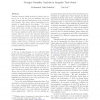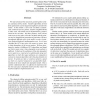139 search results - page 12 / 28 » Recovering Data Models via Guarded Dependences |
SDM
2012
SIAM
11 years 10 months ago
2012
SIAM
Learning temporal causal structures between time series is one of the key tools for analyzing time series data. In many real-world applications, we are confronted with Irregular T...
MCM
2011
13 years 2 months ago
2011
We consider a polymerization (fragmentation) model with size-dependent parameters involved in prion proliferation. Using power laws for the different rates of this model, we reco...
ECOOP
2006
Springer
13 years 11 months ago
2006
Springer
Adaptive Programming (AP) allows for the separate definition of data structures and traversals with attached computations, performed during the traversal, that operate on these dat...
IPPS
2003
IEEE
14 years 25 days ago
2003
IEEE
We had introduced the massively parallel global cellular automata (GCA) model. Parallel algorithms derived from applications can be mapped straight forward onto this model. In thi...
KDD
2010
ACM
13 years 11 months ago
2010
ACM
An ensemble is a set of learned models that make decisions collectively. Although an ensemble is usually more accurate than a single learner, existing ensemble methods often tend ...


